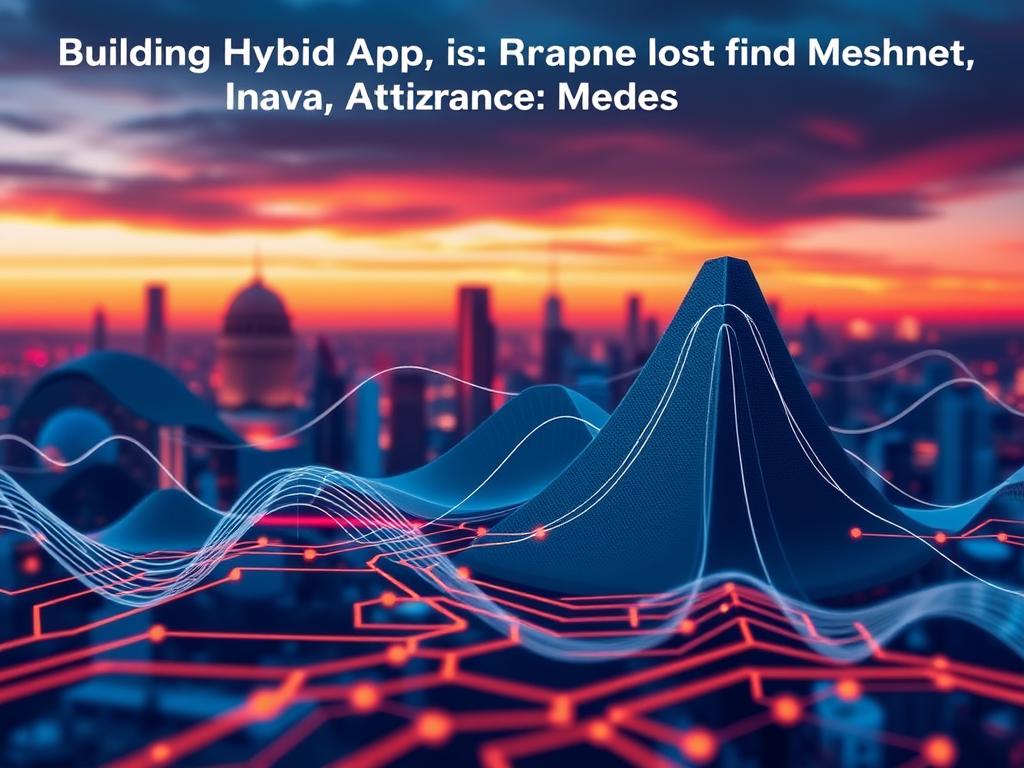Understanding the Hybrid App Landscape

In today’s connected world, the need for apps that work seamlessly across both traditional internet networks and decentralized mesh networks is growing rapidly. Hybrid apps, designed to operate in these dual environments, offer unique advantages. Whether you’re in a dense urban area with strong internet connectivity or a remote location relying on mesh networking, your application can maintain functionality and provide a consistent user experience. But building such apps requires careful planning and understanding of the fundamental differences between internet and meshnet architectures.
Traditional internet relies on centralized servers and well-established infrastructure, whereas meshnets distribute data and routing responsibilities across numerous nodes, typically devices participating directly in the network. When developers build hybrid apps, they tap into the reliability and scalability of the internet, while also taking advantage of the resilience, privacy, and autonomy offered by mesh networks. This balance not only improves app availability but also opens doors for innovative use cases, such as disaster response communication, community networking, and offline-first social platforms.
The Core Challenges of Hybrid Apps
Before diving into development strategies, it’s important to recognize the key challenges when building hybrid apps for both internet and meshnet environments. These challenges primarily stem from disparities in network topology, latency, data consistency, and security frameworks.
- Network Variability: Internet connections are often stable and high-bandwidth, while meshnets can experience fluctuations due to node availability and signal strength.
- Data Synchronization: Ensuring consistency between distributed nodes and cloud servers is complex, especially when connectivity is intermittent.
- Security Concerns: Meshnets may lack centralized trust authorities, requiring developers to implement robust end-to-end encryption and peer authentication mechanisms.
- Resource Constraints: Devices in mesh networks might have limited processing power and battery life, affecting app performance and data handling.
Understanding these challenges helps developers choose the right tools, frameworks, and architectures to build efficient hybrid apps that perform well in both environments.
Key Technologies for Hybrid Internet and Meshnet Apps

A variety of technologies and protocols play crucial roles in enabling hybrid app functionality. Let’s break down some of the essential building blocks for developers venturing into this space.
| Technology/Protocol | Description | Role in Hybrid Apps |
|---|---|---|
| HTTP/HTTPS | Standard protocols for data communication over the internet. | Used for cloud synchronization, API communication, and user authentication. |
| Bluetooth Low Energy (BLE) | Short-range wireless communication technology. | Enables device-to-device mesh networking locally without internet. |
| WebRTC | Real-time communication protocol for peer-to-peer data exchange. | Supports mesh network data transfers and synchronization. |
| Distributed Hash Tables (DHTs) | Decentralized storage system for locating data in distributed networks. | Manages data discovery and routing in meshnets. |
| IPFS (InterPlanetary File System) | Peer-to-peer protocol for storing and sharing hypermedia in a distributed file system. | Facilitates content sharing across mesh and internet. |
| MQTT | Lightweight publish-subscribe network protocol. | Useful for low-bandwidth sensor data and mesh network messaging. |
Choosing the right combination of these technologies based on project scope is pivotal to achieving smooth hybrid app operations.
Design Strategies for Hybrid Apps
Designing an app that operates efficiently on both internet and meshnet requires thoughtful architecture. Here are some proven strategies to consider:
- Modular Network Layers: Abstract the network access into separate modules so that switching between internet and meshnet communication can happen dynamically based on availability.
- Offline-First Approach: Prioritize local data storage and operations that can synchronize once connectivity is available, whether through internet or meshnet.
- Conflict Resolution: Implement conflict-free replicated data types (CRDTs) or operational transformation algorithms to handle synchronization conflicts across nodes.
- Security by Design: Enforce end-to-end encryption and use mutual authentication to safeguard data on mesh networks lacking centralized control.
- Adaptive UI/UX: Design user interfaces that signal network status and gracefully handle delays or offline states, maintaining user trust.
By focusing on these design tenets, hybrid apps can deliver reliable, secure, and user-friendly experiences regardless of network conditions.
Example Architecture

Consider the following simplified architecture diagram for a hybrid app:
| Component | Description | Roles |
|---|---|---|
| User Interface | Front-end layer handling user interaction and feedback. | Displays data, prompts synchronization status, adapts to network changes. |
| Network Abstraction Layer | Manages network connectivity (Internet or Meshnet) dynamically. | Routes data requests to appropriate channels based on availability. |
| Local Storage / Cache | Stores data temporarily for offline usage and quick access. | Maintains app usability during network downtimes. |
| Synchronization Engine | Coordinates data consistency between local storage and remote sources. | Resolves conflicts, manages update queues, schedules synchronization. |
| Security Layer | Implements encryption, authentication, and authorization protocols. | Protects user data and communication integrity. |
This architecture provides flexibility while maintaining robustness across networks.
Development Tools & Frameworks
Numerous tools and frameworks have emerged to support hybrid app development, simplifying tasks and speeding up the build process. Here’s a list of popular choices:
- React Native: Cross-platform framework allowing fast UI development; can integrate native modules for meshnet protocols.
- Flutter: Google’s UI toolkit that supports performant apps on various platforms with plugin support for networking layers.
- Libp2p: Modular network stack used by IPFS to build peer-to-peer applications with mesh capabilities.
- Socket.IO: Facilitates real-time communication and can be adapted for mesh network peer communications.
- PouchDB with CouchDB: Offline-first database syncing smoothly with distributed architectures.
Integrating these tools effectively can accelerate your hybrid app development journey while ensuring maintainability and scalability.
Real-World Use Cases: Why Hybrid Apps Matter
Hybrid apps leveraging both internet and mesh networks unlock numerous practical applications across various domains. Consider these scenarios:
| Use Case | Benefit | Example Application |
|---|---|---|
| Disaster Communication | Provides reliable messaging when infrastructure is down. | Offline messaging apps that sync when networks return. |
| Community Networks | Enables local data sharing without reliance on ISPs. | Local news and social sharing platforms in rural areas. |
| IoT Device Management | Allows devices to communicate locally and sync with cloud for analytics. | Smart home systems that function offline. |
| Privacy-Focused Social Media | Reduces dependence on centralized servers, enhancing user control. | Decentralized chat and content-sharing apps. |
These use cases demonstrate the importance of hybrid apps in increasing resilience, accessibility, and privacy for users worldwide.
Best Practices to Keep in Mind
Building hybrid apps for both internet and meshnet environments is a complex but rewarding endeavor. Here are some best practices to guide your development process:
- Regularly test your app in varied network conditions to uncover edge cases.
- Use robust logging and monitoring to quickly identify synchronization issues.
- Prioritize user education, clearly communicating when the app operates offline or on meshnet.
- Implement graceful degradation to maintain core functionalities even with partial network availability.
- Stay updated with emerging mesh networking standards and portals to future-proof your app.
Following these practices will help deliver a seamless hybrid app experience that users can rely on.
Conclusion
Building hybrid apps that operate smoothly on both the internet and meshnet environments is more relevant than ever as the demand for resilient, decentralized communication grows. While the challenges are significant—ranging from network variability to security concerns—modern technologies, thoughtful design strategies, and powerful development tools make it feasible to build applications that provide continuous access, enhance privacy, and empower users in diverse network conditions. By embracing modular architectures, offline-first principles, and peer-to-peer communication protocols, developers can create hybrid apps that unlock new possibilities in disaster recovery, community engagement, IoT, and beyond. The future of connectivity is hybrid, and mastering the art of building apps for both internet and meshnet will be a key factor for innovation and inclusivity in the digital age.
